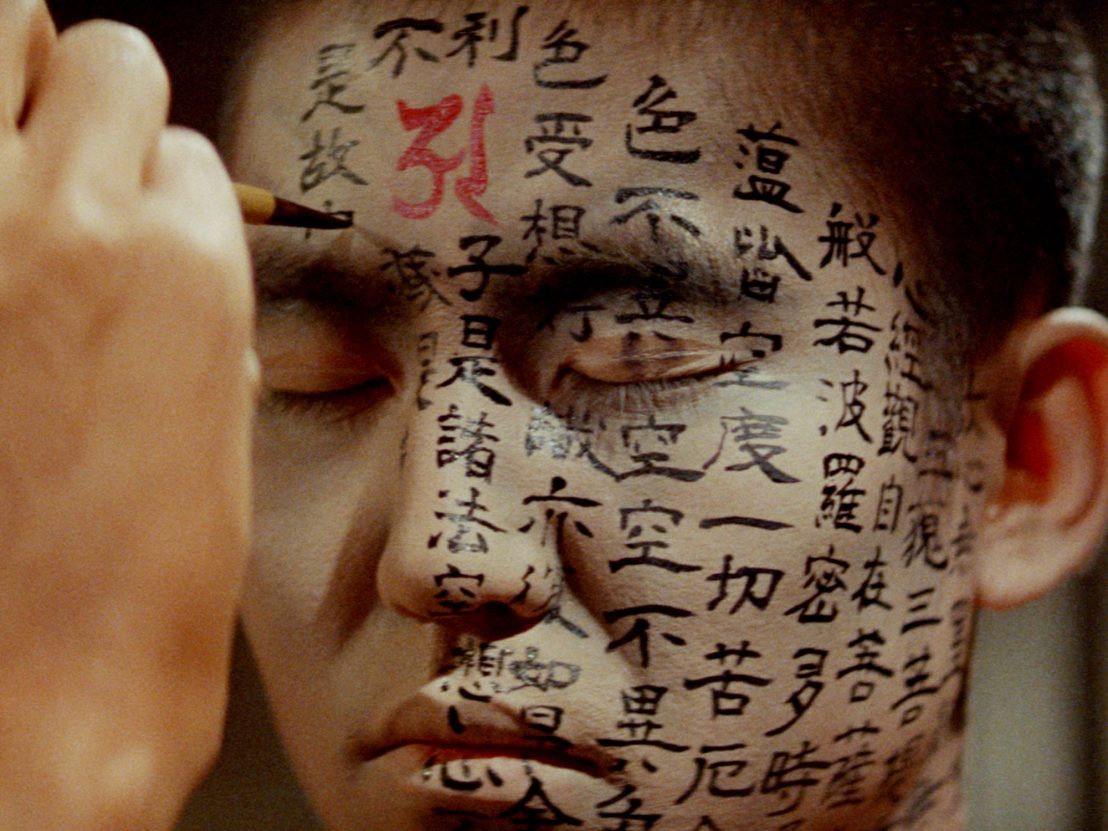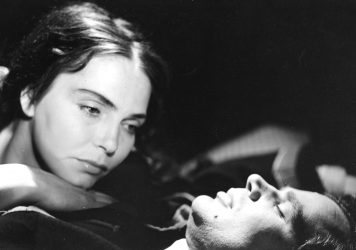
Kwaidan opens with ink: first black ink swirling in clear liquid (on a white background), and then vortices of different colours, eddying and mixing into rich chromatic layers.
This credit sequence (intercut with cast and crew names typewritten on quality paper, as though a book) serves multiple functions: it marks director Masaki Kobayashi’s transition from the monochrome of his previous work to a striking use of Eastmancolor’s full palette; its admixture of different, clashing colours foreshadows the film’s merger of the material and spirit worlds; and, most of all, it points to the film’s literary origins, being adapted by screenwriter Yoko Mizuki from a collection of short stories by Lafcadio Hearn.
The ghost stories (and entomological essays) of ‘Kwaidan: Stories and Studies of Strange Things’ represented part of Hearn’s dispatches from Meiji-era Japan, where the Greek-born, UK-raised, America-based writer settled in 1890, marrying a local woman, fathering four children, and becoming a naturalised citizen (and Buddhist) before his death in 1904. Hearn had long made a journalistic career of exploring the cultural geography of wherever he happened to be posted, and the final chapter of his life in Japan coincided with an emergence of Western interest in the remote nation’s aesthetics.
Hearn was helping, as it were, to put Japan on the map – and in adapting four of Hearn’s tales, Kobayashi too, flush with the success of Harakiri at Cannes (where it won a Special Jury Award in 1963), was hoping to attract more western attention to his national cinema, with Hearn serving as the medium between these two worlds.
The resulting film is abstract, elliptical and ambiguous in its storytelling, painterly in its surreal stylisations and, rounding up to a forbidding three hours, unlikely to appeal beyond the arthouse (although notably it did win the Special Jury Prize at the 1965 Cannes, and was nominated for the Best Foreign Language Film at the Academy Awards). Yet shot mostly on sound stages in constructed sets with highly mannered backdrops, this is a film of a rare, hermetic beauty, full of ethereal images and errant ideas that will haunt the mind.
If all the stories in Kwaidan are set in the past, the first of these immediately sours and complicates any straightforward notion of nostalgia, as the past proves to be an irreparable place of decay, death and horror. For in ‘The Black Hair’, an impoverished samurai (Rentaro Mikuni) abandons his loving wife (Michiyo Aratama), remarries and moves to another part of Japan, all in pursuit of improving his own station, only then to be haunted by his sense of betrayal, guilt and regret.
So over the years he keeps going back – in his mind, in his dreams and perhaps even ultimately in reality – only to face the ruins of his old home, and the monstrousness of his own reflection. As he encounters the ghost of his first wife, now a living presence of devotion, now a skeleton reduced to the “same glossy black hair” that he had once adored so much, he flees through a shifting space, part well-maintained mansion, part dilapidated wreck, where he, more than his long-dead wife, is the real monstrous spectre, caught in a twilight zone between cherished past and desolate present.
The second story, ‘The Woman of the Snow’, concerns a woodcutter, Minokichi (Tatsuya Nakadai), who, spared from freezing to death by a Yuki-onna (Keiko Kishi) on condition that he never tell anyone that he has seen her, survives to marry a pretty young woman and settle into happy family life, before finally, several years later, encountering the ‘snow woman’ a second time.

This entire episode was cut from the version of Kwaidan that screened in the US, in a bid to shorten the film’s running time. But it would be a pity to miss this tale of love and death, with its beautiful snowy sets and vivid backdrops painted with giant eyes, and later with giant red lips, to signify that Minokichi is always being watched by something supernatural with an erotic as much as a deal-guarding interest in him. As befits a tragic romance, this episode comes with a truly bittersweet ending, as the very intimacy of Minokichi’s relationship with his beloved is paradoxically what will drive her from him
Easily my favourite story in the film is the third, ‘Hoichi The Earless’. It opens with the sea battle of Dan-no-ura which was the final catastrophic stand of the Heike clan in 1185. We see a reenactment of the naval encounter, with occasional cutaways to paintings of the same, even as we hear an account of the battle sung to the accompaniment of a lute-like biwa. In other words, from the outset we are made aware that this event, while fixed in history, is also a mediated affair, coming with multiple representation in art (painting, music, epic poem) which, like a tomb, maintain its memory.
Seven hundred years after the battle, a blind novice monk named Hoichi (Katsuo Nakamura), who is renowned for his “uncanny skill at reciting the battle”, is summoned from the local temple to give a nocturnal performance to a Lord and his retinue. As this artist, blind like the epic rhapsodist Homer, recites to his biwa, he does not realise that he is in fact not in a Lord’s great hall, but in the cliff-top graveyard, commemorating the last exploits of the Heike clan to their assembled ghosts. Once the Head Priest (Takashi Shimura) discovers what is going on every night, he intervenes to save Hoichi, with painful consequences for the young monk – even though it is not entirely clear that Hoichi is ever really in any danger or even needs to be saved.
‘Hoichi the Earless’ is an eerily beautiful meditation on the power of art to conjure the past and bring it vividly to life, and so serves as a mise en abyme of Kobayashi’s own period film, which itself resurrects and reenacts not only stories from two different Japanese historical eras, but also the 60-year-old text of Lafcadio Hearn who, having himself lost one eye in his childhood and suffering myopia in the other, was nearly as blind as Hoichi. Closed off through sensory deprivation from this world, Hoichi serves as a medium to the next. And if, in the end, the temple priests can no longer be sure whether the now famous bard’s audience is “fake or real”, his sweet, sad song still goes on.
The final and shortest of the stories, ‘In a Cup of Tea’, is also the most convoluted, reflexive and postmodern, and is, like ‘Hoichi the Earless’, concerned with art. Opening in 1900 (when the real Hearn was writing his own Kwaidan stories) with an unnamed author (played by Osamu Takizawa) at his desk inking a story that the narrator (also voiced by Takizawa) warns will be “curiously unfinished”, it skips to the story itself, set 220 years earlier, in which the squire Kannai (Kan’emon Nakamura) sees the face of a smirking stranger (Noboru Nakaya) impossibly reflected in his tea bowl.
After ill-advisedly swallowing the tea down, the squire then finds himself engaging in a supernatural feud with the ghostly man and his three equally ghostly retainers. As promised, the story does not come to a resolution. Instead, we return to the house of the author in 1900, even if the author himself is mysteriously absent, his work interrupted mid-flow. And so this second unresolved story (about the author) reveals to us, in its final image, how nothing quite “swallows a soul” as well as an involving ghost story. We are left to examine the tea leaves and supplement our own ending.
All four tales are scored by the great Toru Takemitsu, whose electro-acoustic musique concrète constantly has the viewer confused as to where the soundtrack ends and the intradiegetic sound effects begin. Dai Arakawa’s artificial sets, too, keep altering uncannily in appearance (especially in The Black Hair and Hoichi the Earless), with only Hisasho Sagara’s editing to maintain a veneer of continuity. The result is a work somehow both delicate and delirious, as cinematographer Hisashi Sagara’s stately framing can barely contain the more irrational narrative elements which so insistently intrude. It is also cinema at its most unnerving and awe-inspiring.
Kwaidan is available on Blu-ray in a Limited Edition Boxset from Eureka Video’s The Masters of Cinema Series on 27 April.
Published 27 Apr 2020

By Anton Bitel
The prolific filmmaker Teruo Ishii invented a whole new subgenrre with 1969’s bizarre Orgies of Edo.

By Anton Bitel
Shinya Tsukamoto’s Fires on the Plain is a harrowing reminder of the futility and madness of human conflict.

By Anton Bitel
A newlywed woman is transformed into a vampiric beast in Erik Blomberg’s supernatural tale.